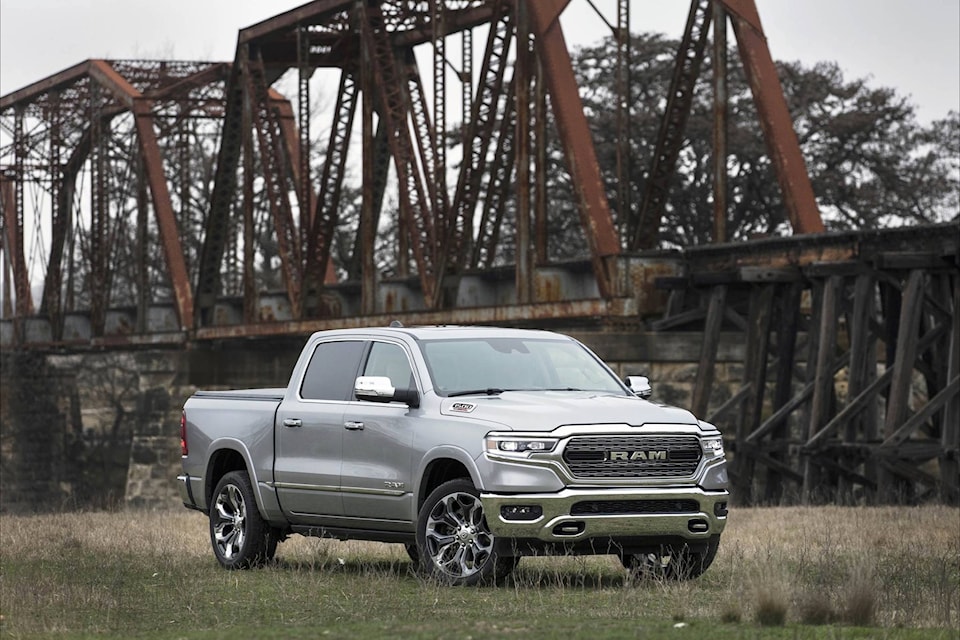The last two model years have seen the adoption of turbo-diesel engines by all domestic-based light-duty pickup brands. That includes the Ram 1500 turbo-diesel that returns to the group for 2020 following a one-year time-out.
In the automotive world, the pickup category is the most hotly contested. Millions are sold in North America every year. Of those, about 95 per cent are made by Ford, General Motors (Chevrolet and GMC) and the Ram division of Fiat Chrysler Automobiles (FCA). The stakes are huge.
The Ram 1500 has made quite a name for itself lately, winning numerous awards and accolades. That and some aggressive marketing has translated into steady sales growth along with a corresponding increase in respect among truck shoppers.
The only piece missing was the turbo-diesel that disappeared for the 2019 model year, primarily due to emission-related issues. But now the so-called EcoDiesel has returned, with added trailer-tugging and cargo-load capacities.
So how do the numbers stack up? The Ram’s made-in-Italy 3.0-litre V-6 puts out 260 horsepower and 480 pound-feet of torque, which is a gain of eight per cent and 14 per cent, respectively. A new turbocharger, redesigned fuel injectors and pistons and increased compression ratio are credited with the improved performance.
The Ford F150 turbo-diesel (also a 3.0-litre V-6) delivers 250 horsepower and 440 pound-feet, and GM’s 3.0-litre inline six-cylinder turbo-diesel in the Chevrolet Silverado and GMC Sierra has 277 horsepower and 460 pound-feet. Yes, the numbers are close, but the Ram holds a definite edge in the crucial torque department.
It’s also a horse race for official fuel economy. GM leads the pack at 8.9 l/100 km in combined city/highway driving, followed by Ram at 9.7 and Ford at 9.8.
The EcoDiesel’s maximum payload and towing capacities have increased to 1,045 and 5,710 kilograms, respectively, from 855 and 4,027 kilograms.
The EcoDiesel can be specified with all Ram body styles and box sizes, including the extended-length Quad Cab and four-door Crew Cab models. A two-door regular-cab version is also available, but only for fleet customers. Most trim levels can be outfitted with the diesel, too, including the Sport and off-road-oriented Rebel.
Aside from the diesel, the Ram is available with a 3.5-litre V-6 that produces 305 horsepower and 269 pound-feet of torque. That can be temporarily increased by up to 90 pound-feet with a belt-drive 48-volt “eTorque†motor/generator. This mild-hybrid system replaces the traditional alternator and uses a lithium-ion battery to add power under hard acceleration.
Optional is a 5.7-litre V-8 that delivers 395 horsepower and 410 pound-feet, and when equipped with eTorque it has slightly more towing capacity than the EcoDiesel at 5,795 kilograms.
All Ram engines are linked to eight-speed automatic transmissions.
Aside from what’s under the hood, the 2020 Ram 1500 has no shortage of tricks up its sleeves to be competitive. The optional air suspension can raise or lower the ride height and keep the truck level when it’s loaded.
Then there’s the trick multi-function tailgate. The split design allows you to open either or both sides, or you can drop the tailgate as a single unit for loading/unloading larger and/or longer objects.
The interior can also be loaded with luxury amenities and a dominating 30-centimetre touch-screen that’s so large it can be split into two screens. It looks intimidating, but the layout is intuitive and the system is easy to use.
Ram EcoDiesel pricing starts at $51,300, including destination charges. That’s about $5,200 more than the base gasoline V-6 and $3,250 more than V8-equipped Rams.
If your work and/or play requirements call for plenty of torque-rich pulling and hauling performance while keeping fuel consumption in check, the updated EcoDiesel option will be most welcome.
What you should know: 2020 Ram 1500 EcoDiesel
Type: Two- /four-door, rear- /four-wheel-drive light-duty pickup
Engine (h.p.): 3.0-litre DOHC V-6, turbo-diesel (260)
Transmission; Eight-speed automatic
Market position: The benefits of diesel power are fuel efficiency and low-speed pulling power. There’s 480 pound-feet of peak torque available at 1,600 rpm. By contrast, the 5.7-litre gasoline V-8 is rated at 410 pound-feet and at a much higher 3,950 revs. The diesel costs more to buy, though.
Points: Redesigned turbo-diesel engine provides greater efficiency and pulling power. • The cost for the optional powerplant seems high, but it more or less in line with competitive turbo-diesel models. • For now, the competition plays second-fiddle for peak torque. • Interior leans on the premium side, especially the oversize U-Connect touch-screen.
Driver assist: Blind-spot warning with cross-traffic backup alert (std.); active cruise control (opt.); emergency braking (opt.); lane departure warning (std.)
L/100 km (city/hwy) 11.1/8.0; Base price (incl. destination) $51,300
Driver assist: Blind-spot warning with cross-traffic backup alert (std.); active cruise control (opt.); emergency braking (opt.); lane departure warning (std.)
MPG (city/hwy) 22/32 ; Base price (incl. destination) $38,600
BY COMPARISON
Ford F-150 turbo-diesel
Base price: $49,000
The Power Stroke V-6 combines strength with decent fuel efficiency.
GMC Sierra turbo-diesel
Base price: $54,250
Diesel engines added to the Sierra and Silverado lineups.
Toyota Tundra
Base price: $42,600
The Tundra and the Nissan do not Titan offer a diesel option for 2020.
If you’re interested in new or used vehicles, be sure to visit to find your dream car today!
-written by Malcom Gunn, Managing Partner at Wheelbase Media
Like us on and follow us on



